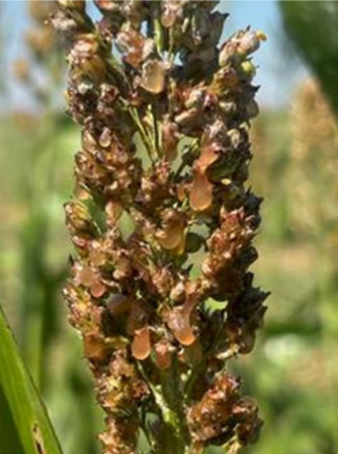
By STACY CAMPBELL
Cottonwood Extension District
In the past week, sorghum ergot has been detected in several locations in Kansas, primarily in forage sorghum fields, but also in grain sorghum. This is a relatively rare event, with notable prior occurrences in 1997 and 2017. Sorghum ergot in the U.S. is caused by the fungus Claviceps africana. Claviceps africana has been reported in Australia, Central America, North America, South America, and South Africa. Sorghum ergot is not the same pathogen that causes ergot in wheat (Claviceps purpurea).
Sorghum ergot development - this fungus, Claviceps africana, infects unfertilized sorghum ovaries, resulting in no development of grain. Pollen present at the same time as ergot inoculum usually prevents ergot infection because pollination occurs much more quickly. The absence of pollen in male-sterile sorghum forage fields makes them extremely susceptible to infection by C. africana when both the pathogen and a favorable environment/weather are present. Sorghum ergot can also be a problem if pollen is somehow absent or ineffective at the flowering stage. This can occur if the plants were subjected to cool, moist conditions prior to or during the flowering period. Anything that reduces pollination increases the potential for ergot infection.
Studies have shown a higher risk of sorghum ergot infection when minimum temperatures are ~53°F. Additionally, the chance of infection decreases when temperatures are above 75°F prior to flowering.
Symptoms and Dispersal - sorghum ergot is a grain replacement disease that creates two major problems.
· First, infection of non-pollinated ovaries precludes normal seed-set or development. Thus, infections are directly responsible for grain yield losses.
· Secondly, seed developing adjacent to infected florets often become contaminated with sugary, sphacelia honeydew, which is a sweet, sticky, amber-colored fluid (Figure 1).
Ergot infection is easy to identify because of the abundance of honeydew that the fungus produces. Thick, sticky, ambered colored, syrup-like honeydew drips from the sorghum head to the leaves and to the ground, where it often dries in a white powdery like substance. The honeydew also sometimes appears as a dried brown to black colored mass in place of kernels in the sorghum head.
Is ergot in sorghum toxic to cattle and other livestock?
We are not aware of any issues with toxicity in the past or present in the US caused by the ergot fungus Claviceps africana that infects sorghum. This includes forage fed as silage or hay. It is very important to note that this is not the same ergot fungus that infects wheat, rye, triticale and fescue. The honeydew itself contains very little toxin (alkaloids). In the sorghum head, instead of grain being produced, a compact, hard fungal mass called sclerotia may develop in the later stages of infection. It has a tough outer rind and a compact inner core that may be reddish brown in color and replaces kernels. Do not confuse this with dried honeydew or secondary infections. These sclerotium fall to the ground or are generally separated from the grain during processing. These sclerotia would be expected to have a higher level of alkaloids. However, it is important to note that in the High Plains, there is some question about whether sclerotia is even produced.
Management considerations
· Fungicide applications at this point in time will not be effective.
· Harvesting of sorghum, for grain or silage, may prove difficult due to the sticky nature of the honeydew.
· If portions of the field are more severely affected than others, producers may consider not harvesting that portion of the field or keeping the resulting hay lots separate for future testing.
· Delaying harvest until after a rain or freeze can help reduce the amount of honeydew on the plant.
· Honeydew can cause mold formation in baled hay or silage. Mold formation will reduce feed quality and can form mycotoxins.
· The presence of alkaloids, which are a toxic concern for livestock feeding, is reliant on the production of sclerotia. At this time, sclerotia production has not been verified in Kansas fields.
K-State Extension is continuing to monitor this situation and evaluate the infections present in Kansas. If you have any additional questions please reach out to us in the Cottonwood Extension District.
Information provided by Rodrigo Onofre, K-State Extension Row Crop Plant Disease specialist.
Stacy Campbell is a Crop Production Extension agent in the Cottonwood District (which includes Barton and Ellis counties) for K-State Research and Extension. You can contact him by e-mail at [email protected] or by calling 785-628-9430.






